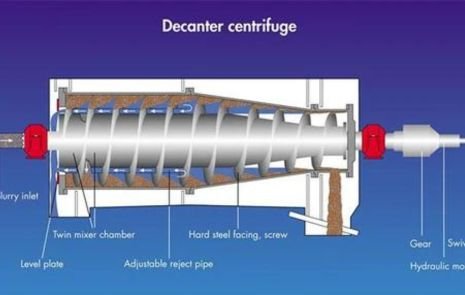Decanter Centrifuges – A Sustainable Solution for Solid-Liquid Separation
Using mechanical separation systems instead of chemical-based ones reduces water and energy consumption. This minimizes waste handling and tailings dam requirements while improving the intrinsic safety of the operation.
Decanter centrifuges separate one solid material from a liquid or multiple liquids through high centrifugal force and continual rotation. They are ideal for 3-phase separation, such as producing edible oils like olive oil, processing oil sludge and creating biodiesel.
Benefits
Decanter centrifuges are highly efficient for the separation of solids from liquid. They produce a lower moisture content solids discharge than a thickener or filter press, requiring less maintenance and water usage.
The centrifugal force compacts the solids and expels the excess liquid through the bowl discharge ports. The clarified liquid flows over dam plates at the bowl’s opposite end into a stationary casing that incorporates baffle plates to prevent remixing. Discharge chutes or hoppers are attached under the case to collect the separated materials. Based on pilot-scale trials, analytical scale-up methods can be used to determine the dimensioning of an industrial decanter centrifuge. This involves calculating the s-values of the experimentally measured parameters. This allows the transport efficiency of the consolidated sediment to be calibrated at one scale, which is then used for the simulation of industrial-scale decanter centrifuges. This approach is relatively flexible and can cope with changes in material characterization and centrifugal acceleration.
Costs
Depending on the industrial application, decanter centrifuges can be a cost-effective solution. The key to success is selecting the right model for the specific process and ensuring proper size and capacity. This requires an analysis of the product properties and decanter design features, such as auger pitch, beach cone angle and gearbox ratio. Decanter centrifuge equipment durability and maintenance costs are also important. The rotating parts exposed to high stresses are machined from high-strength, weld-free, centrifugally cast stainless steel, which provides strength, unparalleled reliability and an extremely long life span.
Environmental Impacts
Decanter centrifuges are a green solution for wastewater sludge dewatering because they reduce chemical use, eliminate labor costs for emptying and transporting waste, and minimize landfill waste. They also offer a higher level of hygiene than other separation technologies. In a typical decanter centrifuge, the fast rotation of the bowl creates a high centrifugal force that moves denser solids outward and displaces liquid inward. The rotating bowl is connected to a drill, or scroll, that rotates at a slower speed than the bowl. The planetary gearbox attached to the training drives it, scraping or pushing the solids up the ‘beach’ and into the solids discharge ports at the end of the bowl.
Decanter centrifuges are easy to install and require very little floor space compared with other separator technologies.
Conclusions
Decanter centrifuges are a mechanical separation technology that offers benefits over other types of equipment. The centrifugal force generates graded settling, which separates liquid and fine solids. This method is particularly suited to situations where the solids have a higher specific gravity than the fluid, such as oil sludge. The process fluid enters the decanter centrifuge through an inlet SS pipe. The screw conveyor and the bowl compose a transmission mechanism that rotates at a differential speed with a gearbox lag. The decanter centrifuge’s high-speed rotation creates a powerful centrifugal force that transfers the separated fluid into a circular annular liquid pool at the bottom of the bowl.
The clarified liquid stream overflows the dam plates at the opposite end of the bowl. Baffles inside the decanter reroute the streams to ensure the correct flow path and prevent cross-contamination. The drained, compressed solids discharge through ports in the bowl assembly and are carried away on a conveyor. These machines can be configured with adjustable weir plates to vary the volume of surface wetting fluid in the center. Regularly checking vibration and temperature will help maintain proper operation.









